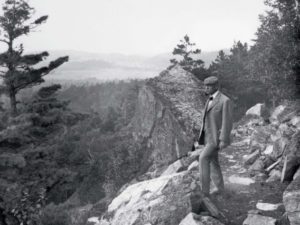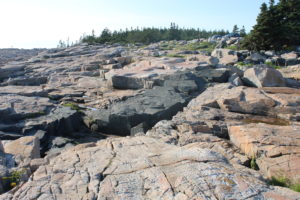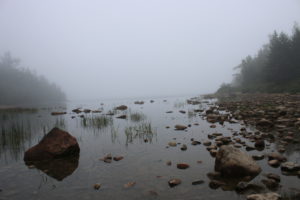Acadia National Park, on the Maine coast, was established on January 19, 1929. The park, which today covers more than 47,000 acres, covers a substantial portion of Mount Desert Island and a number of islands in the surrounding region. The park hosted more than 3.3 million visitors in 2017, placing it in the top 10% of all National Park Service units.
Acadia began as Sieur de Monts National Monument, dedicated in 1916, becoming the first national park unit on the Atlantic seaboard. Unlike many national parks that have always been property owned by the federal government, Acadia started out as private lands. The park owes its existence to the persistent efforts of George B. Dorr, who fostered the creation, expansion and maintenance of the park for decades.

George Dorr was born to a wealthy Boston family in 1853. Like many northeasterners at the time, the family vacationed on Mount Desert Island. The striking beauty of the area had been made famous by the most well-known landscape painters, including Thomas Cole and Frederic Church, attracting big-city residents seeking a peaceful refuge from their hectic lives. The rounded mountains, carved by the last glaciation, are interspersed with bare rock surfaces and gnarled evergreens. Native Abnaki Indians called the island “Pemetic,” meaning sloping land. When French explorer Champlain ran aground in the area in the early 1600s, he called the island “Isles des Monts Desert,” or Island of Barren Mountains. George Dorr appreciated its singular beauty, as he wrote in 1916:
“There is nothing like it elsewhere on the continent. A noble mass of ancient granite that once bore up a dominating Alpine height on its broad shoulders has been laid bare by time immeasurable and carved into forms of bold and striking beauty by recent ice-sheet grinding. This granite mass, surrounded broadly by the ocean as the coast has sunk, constitutes with its ice-worn peaks and gorges and intervening lakes the national monument.”

Dorr fell in love with the island on childhood vacations and moved there permanently as a young man. Wealthy and a lover of nature, he never married—dedicating his life instead to the preservation of the land that obsessed him. Fearing that the island would be overtaken by commercial lumbering and unbridled tourism, he formed a land conservancy in 1913 that bought 6,000 acres. He donated the land to the federal government, and on July 8, 1916, Sieur de Monts National Monument was signed into law by President Woodrow Wilson. A few years later—spurred by the incessant lobbying of George Dorr—Congress and President Wilson re-designated the monument as Lafayette National Park. Then, on January 19, 1929, the park was renamed Acadia. Dorr was made superintendent of the park and worked unceasingly for its benefit until his death in 1944.
Over time, the park has expanded from the original 6,000 acres to its current size of nearly 48,000 acres, all through donations and purchases of private lands. The park makes extensive use of conservation easements, by which private landowners guarantee that their lands will remain wild and natural. These easements cover dozens of islands, large and small in the surrounding waters of the Atlantic Ocean, and continue to increase the national treasure of the Acadia region.

References:
Dorr, George B. 1916. The Sieur de Monts National Monument. US Government Printing Office. Available at: http://digitalcommons.library.umaine.edu/cgi/viewcontent.cgi?article=1089&context=mainehistory. Accessed January 18, 2017.
Hartford, George A. Mount Desert Island, Maine. Available at: http://www.acadiamagic.com/MountDesert.html. Accessed January 18, 2017.
National Park Service. George B. Dorr. Available at: https://www.nps.gov/people/george-b-dorr.htm. Accessed January 18, 2017.
National Park Service. History of Acadia. Available at: https://www.nps.gov/acad/learn/historyculture/history-of-acadia.htm. Accessed January 18, 2017.

